It was great to catch my friend Robert Stephens, founder of Geek Squad and now CTO of Best Buy, this morning at breakfast. It was right before his opening keynote, and he gave me kind of a sneak peak to his talk. We covered a lot of topics, and could have gone on even longer… here's the 10-minute interview:
Category: Best Buy (Page 2 of 2)
I had the good fortune to get my hands on a very cool, brand-new gadget in late May before it was due to hit stores in June, thanks to my friend Robert Stephens, CTO of Best Buy. He asked me to shoot video interviews at the Glue Conference, which he wasn't able to attend, and I told him I'd love to try it with a new device I'd just heard about, the Olympus LS-20M, if he could get me a review unit. He scored one for me a day or two later, and I ultimately shot 18 interviews at the conference, May 24-26 in Denver (all of which appear just prior to this post). My net assessment: I loved it!
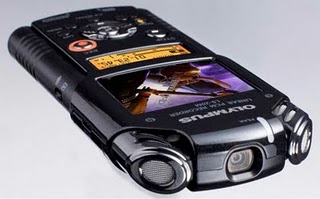 This is one heckuva device for the money (list price $299), really unlike anything before it that I had seen. In a sentence, here's how Olympus describes it: "The new LS-20M is the first Olympus recorder that captures and edits 1080p HD video while recording 24 bit/96 hHz Linear PCM stereo sound…(it) enables users to create home movies that look and sound like professional productions in a device that’s so compact it fits in your pocket."
This is one heckuva device for the money (list price $299), really unlike anything before it that I had seen. In a sentence, here's how Olympus describes it: "The new LS-20M is the first Olympus recorder that captures and edits 1080p HD video while recording 24 bit/96 hHz Linear PCM stereo sound…(it) enables users to create home movies that look and sound like professional productions in a device that’s so compact it fits in your pocket."
I like to call it a hand-held, studio-grade recorder, the same way I'm used to describing my Olympus LS-10 — but that's an audio-only device, which I've been doing interviews with for a couple of years. This adds HD video to my game (finally) and, combined with high-quality audio, lets me record much more interesting interviews at all the conferences I attend. Sure, I've had an iPhone for some time and shoot videos with that, but not for serious journalistic kinda stuff, and I somehow never got around to buying a Flip (and why would I now that Cisco killed it off?).
Summary of My Experience:
• The device was very easy to use. The review unit I received came without a manual (because it wasn't printed yet), but I was able to quickly figure out how to operate it. Of course, I had the advantage of having used the LS-10, and the controls are very similar. I just began shooting video interviews without even practicing first. (And some of my interviews show it!) I was challenged by difficult lighting conditions, and it did take me a while to get the hang of shooting with it, but I was generally pleased with how my candid interviews turned out. They averaged 3-4 minutes in length.
• Using a mini-tripod as a handle is the only way to go when doing hand-held interviews. (There's a screw-mount in the bottom of the unit.) I was used to doing this with my LS-10, to aim the device, and of course it's even more critical when shooting video! 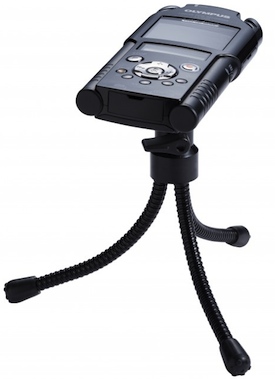 My mini-tripod is 4-5 inches high when fully closed and fits perfectly in my hand to support the device and hold it conveniently and comfortably for shooting. A mini-tripod can also double as a stand when doing tabletop interviews, as shown in the accompanying photo (this one and others copyright GizMag, and see the link to their article below). My tripod is smaller than this one and has straight legs, so it's ideal doubling as a handle.
My mini-tripod is 4-5 inches high when fully closed and fits perfectly in my hand to support the device and hold it conveniently and comfortably for shooting. A mini-tripod can also double as a stand when doing tabletop interviews, as shown in the accompanying photo (this one and others copyright GizMag, and see the link to their article below). My tripod is smaller than this one and has straight legs, so it's ideal doubling as a handle.
• I bought a high-speed 16GB SD card to use with my LS-20M review unit, to make sure I'd have hours of recording capacity while I was doing all my interviews at the conference. The LS-20 comes with a 2GB card, but that won't hold a lot of video. (Note: you can alternately do audio-only recording with the unit, via a switch on the right side, and MP3s take up a lot less space.)
• The fact that the unit does not have little wheels for volume and audio level on the side is a good thing, as I found with the LS-10 that they could inadvertently be adjusted too low without me realizing it! (All such controls were thankfully made digital on the LS-20M, accessible via the Menu button.)
• The unit doesn't have built-in wifi, so there's no "Upload to YouTube" button. But in my experience at the conference (which had very good wifi), I simply pulled my SD card, put it into a reader, plugged it into a USB port on my MacBook, and quickly uploaded my short videos via the YouTube site. Then, I simply copy-pasted the URL for each video into the Typepad new-post interface, entered a title, clicked publish — and, voila, each video was published as its own post. I was able to post several videos each day of the two-day event, just by working a bit during breaks.
What Could be Improved?
• The one big issue with the LS-20M is the fixed, front-mounted lens, between the dual mics (which you can see in the top photo). That makes viewing the LCD screens a challenge when you're shooting. In order to see the shot you're framing, you have to angle the unit upwards a least a little, and shooting up at a subject is not the most flattering angle. I had to be very aware of this while I was shooting, constantly trying to minimize the angle while craning my neck to see my shot. 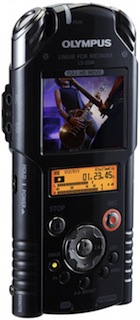 (Otherwise, it is so crazy-easy to chop someone's head off!)
(Otherwise, it is so crazy-easy to chop someone's head off!) 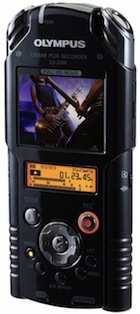 I got used to that quickly, though, and was able to shoot pretty good video, adequate for my needs. Suggestion to Olympus: make the lens rotatable downward! Even just 15 degrees or so would help immensely. I will not be surprised to see that improvement in the next release of the product. It is a design shortcoming.
I got used to that quickly, though, and was able to shoot pretty good video, adequate for my needs. Suggestion to Olympus: make the lens rotatable downward! Even just 15 degrees or so would help immensely. I will not be surprised to see that improvement in the next release of the product. It is a design shortcoming.
• The small LCD screen below the main one is okay, but I noticed the little icon for battery capacity only after I'd run out of battery in the middle of an interview! It was crammed into the upper right of the display. The charger worked quite fast, though, and I found the battery life to be good. (I didn't time it, but it seemed like several hours.)
Those were really my only complaints about the unit. It worked flawlessly otherwise, and the quality of the video and the audio is nothing short of tremendous. I would whole-heartedly recommend the LS-20M for anyone needing to do journalistic, remote/on-site interviews as I do. Beyond that usage, however, the device will surely be popular for general consumer use, including family videos. I didn't even mention (nor did I need to use) this cool feature: it comes with four different optional "Magic Movie" special-effect filters. But I will surely give those filters a try for personal videos, once I get my own unit. I do intend to make the LS-20M my video cam of choice when I want to capture serious, quality videos. The quality of cell phone videos (including the iPhone) only goes so far — especially the audio. And the LS-20M is easy to take with you in its nice, little zippered black-fabric case. One cool optional accessory is a remote control, which would be be handy in situations where you want the unit stationary or on a tripod, and you need to start and stop the recording — say at an event like a concert or a wedding.
Other sites have written about the LS-20M, at least when it was first announced. I'm not aware of any other reviews yet based on hands-on usage, however. Here are four of the best reports I read on the device, all published in early May:
• Engadget
• GizMag
The LS-20M will be available in stores and from online sites sometime in June — the company didn't say exactly when. Retail is $299, but I see prices as low as $230 already listed online, and I assume some sites may be accepting pre-orders now.
(Note: This post first appeared earlier today at Minnov8.com.)
Ever been burned buying a consumer electronics product right before a price reduction and wished you’d have waited? Or, how many times have you been burned and not even known it? Now there’s a solution for both these problems: it’s called Gazaro Protect.  Gazaro is a company that’s been developing a cloud-based, realtime retail pricing platform for several years, using artificial intelligence technology, and is focused initially on consumer electronics. Today, it announced its new pricing protection service, including an iPhone app.
Gazaro is a company that’s been developing a cloud-based, realtime retail pricing platform for several years, using artificial intelligence technology, and is focused initially on consumer electronics. Today, it announced its new pricing protection service, including an iPhone app. 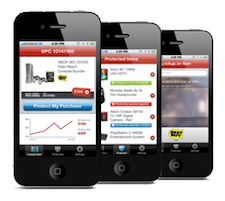
Maybe you’re thinking you missed out on the best prices on Black Friday or Cyber Monday? Well, get this: Gazaro’s research shows average pricing on featured products at Best Buy during the 2009 Holiday Season was actually lower in the week before December 25 than it was on Black Friday or Cyber Monday (see chart). One in three products dropped in price during the holiday season, with an average price drop of about 15%. Gazaro says its new service helps you take advantage of these price drops. 
How does it work? Using either Gazaro’s web site or its new iPhone app, Gazaro Protect lets consumer electronics shoppers lock in the lowest prices by letting them know when a price drops after they buy, so they can then go get money back. It’s a free web service and mobile app that automatically notifies you of these money-saving price adjustments after you buy. The net advantage, Gazaro says, is you get last-minute holiday prices without having to fight the crowds, or risk a product being sold out if you wait too long.
It’s common for retailers to have policies to refund money to shoppers when products they purchase subsequently drop in price. However, here’s the key: most shoppers don’t collect their price adjustments because of the manual effort to track prices. Of the shoppers surveyed by Gazaro in October 2010, fully 68% did not claim a single price adjustment in the last 12 months. The patent-pending Gazaro Protect service saves shoppers money by automatically notifying them of eligible price adjustments on the products they purchase. In an analysis of 2009 Holiday Season pricing on 120,000 consumer electronics products, including computers, 15% dropped in price by an average of $25.61. And if you doubt just how many products have price drops, check out this following chart showing just how high the percentages are, at several retailers (Best Buy included).
As the company points out, saving money is at the top of most shoppers’ minds in our uncertain economy. Check these stats Gazaro provides: 98% of shoppers surveyed stated they’re willing to claim a price adjustment if they’re notified of it, and 94% are willing to claim price adjustments of anything over $10 in value. 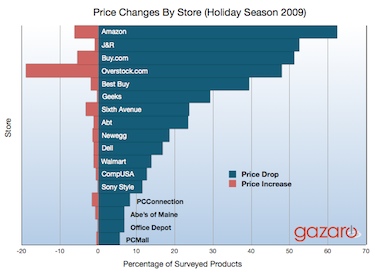
Gazaro Protect is free for shoppers, and is available by email, website, and as an iPhone app. It is initially featuring only Best Buy products, made available through the BBYOpen platform (an open API), with Gazaro promising “increased functionality for shoppers in the near future.”
Here are three sample use-case scenarios the company provided:
• Mobile: Randy buys a digital camera, and scans the product’s bar code or enters the product’s UPC using the Protect iPhone app. Gazaro registers the product, and automatically tracks the price drops against the store’s price match policy. Randy returns to the store to get his price adjustment when Gazaro notifies him of a price drop. Notification can be by text message or email.
• Email: David buys a printer at the store’s website, and forwards the receipt to protect@gazaro.com. Gazaro automatically parses the receipt information to register the product, and automatically tracks price drops against the store’s price match policy. David calls the store to get his price adjustment when Gazaro notifies him of a price drop.
• Web: Jane buys a flat-screen television in the store or online at the store’s website. She copies and pastes the URL or SKU of the product from the store’s website into the Gazaro Protect website. Gazaro registers the product, and automatically tracks price drops against the store’s price match policy. Jane returns to the store to get her price adjustment when Gazaro notifies her of a price drop.
I spoke with Alexander Rink, Gazaro’s CEO, who said, “Gazaro Protect enables shoppers to buy with peace of mind, locking in low prices by getting money back if prices drop. And it helps retailers by removing shopper doubt at the point of sale, and by creating a positive experience that encourages customer loyalty.” Rink sees his company’s technology as a natural evolution for retail. “It’s a clear win for shoppers — they will increasingly demand this type of service. They want to know they got a good deal. Traditionally, that’s meant looking for a good deal before they buy — which Gazaro also helps shoppers do at our web site — but Protect extends that to after they buy.”
Rink said that smart retailers are increasingly thinking ahead about converting transactions into relationships, “where they take care of the customer before, during, and after the purchase, and make it easy for them to return for their next purchase. Gazaro is the leading the way in thinking of the whole ‘customer lifecycle’ in this way.”
The Gazaro Protect iPhone app is now available in the App Store, and the company plans an Android app “in the near future.” 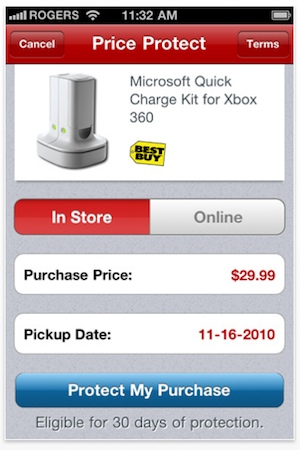 The Gazaro Protect web site is free to use for all online and offline shoppers, and online shoppers can also get protected by simply forwarding their store email receipts to protect@gazaro.com — as noted above, for purchases made on BestBuy.com.
The Gazaro Protect web site is free to use for all online and offline shoppers, and online shoppers can also get protected by simply forwarding their store email receipts to protect@gazaro.com — as noted above, for purchases made on BestBuy.com.
“Gazaro stands for honest recommendations to help shoppers get the best value for their money,” said Sam Zaid, Founder and CTO in the company’s news announcement. “Gazaro Protect leverages Gazaro’s cloud-based, real-time Retail Pricing Platform to provide a compelling free service for shoppers, and a customer care differentiator for retailers.”
For more about Gazaro, hit the company’s media page and its blog. The company says it “enables shoppers to buy with peace of mind by certifying great deals in real-time, and protecting them after the purchase.” It says it analyzes hundreds of thousands of price points on thousands of computers and electronics products every day, identifying great deals. Its intent is to guide shoppers to smart purchase decisions, and provide retailers with real-time pricing data and analytics.
I requested an interview directly with a manager at BBYopen about Gazaro Protect, but got a curt reply back from the company’s PR department saying it did not want to comment at this time.
Here’s a code for the first 100 people reading this post to get 50% off the price of the “Pro” version of the Gazaro Protect iPhone app: gazaroTSB50. The normal price for an in-app upgrade to Pro is $1.99, so the 50% discount will take that to $0.99. The Pro version unlocks the barcode scanner and gives you unlimited “protects,” while the free version of the app only allows you to protect one product.
(UPDATE 12/3/10: I broke this story when I posted it on Minnov8 yesterday, then several other sites covered it, including CNet, GigaOM, and Lifehacker. Gazaro now tells me they’ve decided to get more generous. They’re allowing our next 250 readers to upgrade to the Pro version of the Gazaro Protect iPhone app for FREE. Just first download the free version of the app, then upgrade in-app using this code: FREEMONEYTSM.)

Recent Comments